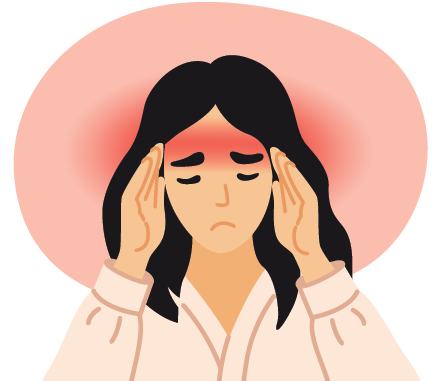HealthXchange will NEVER ask you to transfer money over a call. If in doubt, call the 24/7 ScamShield helpline at 1799, or visit the ScamShield website at www.scamshield.gov.sg.

All migraines are headaches but not all headaches are migraines. Dr Nancy Dang, Associate Consultant, Neurology, NNI, explains the different types of headaches and the unique features of migraines.
A headache refers to pain in any region of the head. This complaint is very common – around half to three quarters of adults in the world are reported to have suffered a headache in the past year.
There are several types and causes of headache; however the most common are:
Tension headache
This is the most common type of headache and has no other symptoms. Pain usually ranges from mild to moderate and is often described as feeling like a tight band pressing on the forehead and around the head.
Cluster headache
A cluster headache always occurs on the same side of the head, usually over the eye or temporal region, accompanied by droopy eyelid, redness of the eye, tearing, nasal congestion, and/or restless or agitation.
Migraine
Migraine affects up to 12% of the general population, and is more common in women than men. The pain is usually moderate to severe, and has distinct features not seen in other types of headaches.
Distinctive features of migraines
A migraine typically lasts from four hours to three days and goes through four phases:
1) Prodrome
Yawning, irritability and mood disturbance are frequently reported one to two days before the onset of headache.
2) Aura
About 25% of people with migraine experience aura, which is most often visual symptoms such as zig-zag lines, and sparkling or shimmering spots. Other aura symptoms can affect the sensory feeling, speech or limbs which may cause difficulty speaking clearly or tingling in the face or hands. Aura symptoms usually develop gradually over a few minutes and last less than one hour.
3) Headache
This is often on one side of the head. Pain can be moderate to severe and is often described as throbbing. It is usually accompanied by other symptoms such as nausea, vomiting and/or sensitivity to light or sound. Many people with migraine prefer to rest in a dark and quiet room during the headache attack.
4) Postdrome
Tiredness and lack of concentration after the headache has gone. This can last for one to two days.
Preventing migraines
Every person is unique but there are some common factors that can trigger a migraine. These include:
- Stress
- Sleep disturbances
- Fasting
- Certain foods; e.g. chocolate, cheese, red wine
- Menstruation
- Bright light
It is important to recognise headache triggers and to avoid them as much as possible to reduce headache attacks. Keeping a headache diary and tracking when headaches occur, the type and intensity of pain, and what you were doing and eating before the headache attack can help identify triggers and make it easier to describe your symptoms should you need to see a doctor.
Various headache diary apps are currently available on smartphones, which can make it more convenient for people to track their headaches.
This article was published in the National Neuroscience Institute's NeusLink magazine, which covers articles about NNI updates and brain, spine, muscle and nerve conditions in English and Chinese - to read more articles click here!
Check out another related article:
When to see a doctor for headache
Get the Health Buddy App
© 2025 SingHealth Group. All Rights Reserved.













 Get it on Google Play
Get it on Google Play